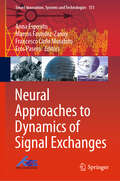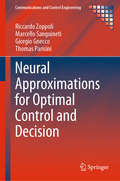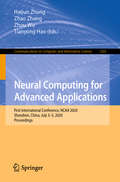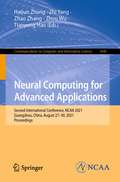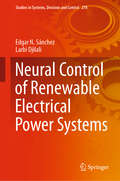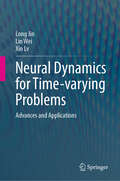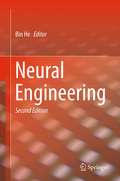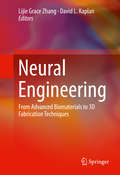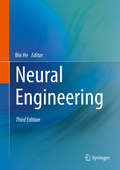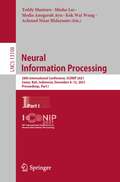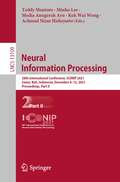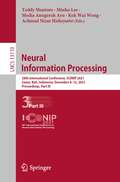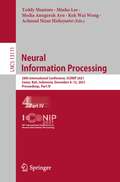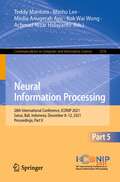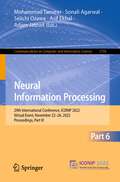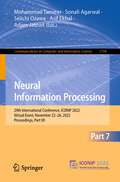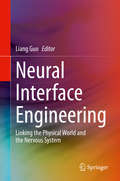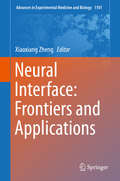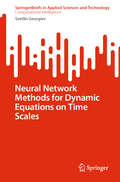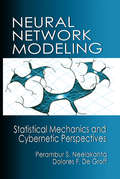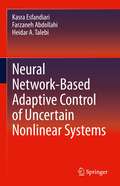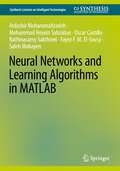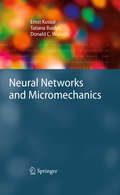- Table View
- List View
Neural Approaches to Dynamics of Signal Exchanges (Smart Innovation, Systems and Technologies #151)
by Anna Esposito Marcos Faundez-Zanuy Francesco Carlo Morabito Eros PaseroThe book presents research that contributes to the development of intelligent dialog systems to simplify diverse aspects of everyday life, such as medical diagnosis and entertainment. Covering major thematic areas: machine learning and artificial neural networks; algorithms and models; and social and biometric data for applications in human–computer interfaces, it discusses processing of audio-visual signals for the detection of user-perceived states, the latest scientific discoveries in processing verbal (lexicon, syntax, and pragmatics), auditory (voice, intonation, vocal expressions) and visual signals (gestures, body language, facial expressions), as well as algorithms for detecting communication disorders, remote health-status monitoring, sentiment and affect analysis, social behaviors and engagement. Further, it examines neural and machine learning algorithms for the implementation of advanced telecommunication systems, communication with people with special needs, emotion modulation by computer contents, advanced sensors for tracking changes in real-life and automatic systems, as well as the development of advanced human–computer interfaces. The book does not focus on solving a particular problem, but instead describes the results of research that has positive effects in different fields and applications.
Neural Approximations for Optimal Control and Decision (Communications and Control Engineering)
by Riccardo Zoppoli Marcello Sanguineti Giorgio Gnecco Thomas ParisiniNeural Approximations for Optimal Control and Decision provides a comprehensive methodology for the approximate solution of functional optimization problems using neural networks and other nonlinear approximators where the use of traditional optimal control tools is prohibited by complicating factors like non-Gaussian noise, strong nonlinearities, large dimension of state and control vectors, etc. Features of the text include: • a general functional optimization framework; • thorough illustration of recent theoretical insights into the approximate solutions of complex functional optimization problems; • comparison of classical and neural-network based methods of approximate solution; • bounds to the errors of approximate solutions; • solution algorithms for optimal control and decision in deterministic or stochastic environments with perfect or imperfect state measurements over a finite or infinite time horizon and with one decision maker or several; • applications of current interest: routing in communications networks, traffic control, water resource management, etc.; and • numerous, numerically detailed examples. The authors’ diverse backgrounds in systems and control theory, approximation theory, machine learning, and operations research lend the book a range of expertise and subject matter appealing to academics and graduate students in any of those disciplines together with computer science and other areas of engineering.
Neural Computing for Advanced Applications: First International Conference, NCAA 2020, Shenzhen, China, July 3–5, 2020, Proceedings (Communications in Computer and Information Science #1265)
by Haijun Zhang Zhao Zhang Tianyong Hao Zhou WuThis book presents refereed proceedings of the First International Conference Neural Computing for Advanced Applications, NCAA 2020, held in July, 2020. Due to the COVID-19 pandemic the conference was held online. The 36 full papers and 7 short papers were thorougly reviewed and selected from a total of 113 qualified submissions. Thes papers present resent research on such topics as neural network theory, and cognitive sciences, machine learning, data mining, data security & privacy protection, and data-driven applications, computational intelligence, nature-inspired optimizers, and their engineering applications, cloud/edge/fog computing, the Internet of Things/Vehicles (IoT/IoV), and their system optimization, control systems, network synchronization, system integration, and industrial artificial intelligence, fuzzy logic, neuro-fuzzy systems, decision making, and their applications in management sciences, computer vision, image processing, and their industrial applications, and natural language processing, machine translation, knowledge graphs, and their applications.
Neural Computing for Advanced Applications: Second International Conference, NCAA 2021, Guangzhou, China, August 27-30, 2021, Proceedings (Communications in Computer and Information Science #1449)
by Haijun Zhang Zhi Yang Zhao Zhang Tianyong Hao Zhou WuThis book presents refereed proceedings of the Second International Conference Neural Computing for Advanced Applications, NCAA 2021, held in Guangzhou, China, in August, 2021. The 54 full papers papers were thorougly reviewed and selected from a total of 144 qualified submissions. The papers are organized in topical sections on neural network theory, cognitive sciences, neuro-system hardware implementations, and NN-based engineering applications; machine learning, data mining, data security and privacy protection, and data-driven applications; neural computing-based fault diagnosis, fault forecasting, prognostic management, and system modeling; computational intelligence, nature-inspired optimizers, and their engineering applications; fuzzy logic, neuro-fuzzy systems, decision making, and their applications in management sciences; control systems, network synchronization, system integration, and industrial artificial intelligence; computer vision, image processing, and their industrial applications; cloud/edge/fog computing, the Internet of Things/Vehicles(IoT/IoV), and their system optimization; spreading dynamics, forecasting, and other intelligent techniques against coronavirus disease (COVID-19).
Neural Control of Renewable Electrical Power Systems (Studies in Systems, Decision and Control #278)
by Edgar N. Sánchez Larbi DjilaliThis book presents advanced control techniques that use neural networks to deal with grid disturbances in the context renewable energy sources, and to enhance low-voltage ride-through capacity, which is a vital in terms of ensuring that the integration of distributed energy resources into the electrical power network. It presents modern control algorithms based on neural identification for different renewable energy sources, such as wind power, which uses doubly-fed induction generators, solar power, and battery banks for storage. It then discusses the use of the proposed controllers to track doubly-fed induction generator dynamics references: DC voltage, grid power factor, and stator active and reactive power, and the use of simulations to validate their performance. Further, it addresses methods of testing low-voltage ride-through capacity enhancement in the presence of grid disturbances, as well as the experimental validation of the controllers under both normal and abnormal grid conditions. The book then describes how the proposed control schemes are extended to control a grid-connected microgrid, and the use of an IEEE 9-bus system to evaluate their performance and response in the presence of grid disturbances. Lastly, it examines the real-time simulation of the entire system under normal and abnormal conditions using an Opal-RT simulator.
Neural Dynamics for Time-varying Problems: Advances and Applications
by Long Jin Lin Wei Xin LvThis book mainly presents methods based on neural dynamics for the time-varying problems with applications, together with the corresponding theoretical analysis, simulative examples, and physical experiments. Based on these methods, their applications include motion planning of redundant manipulators, filter design, winner-take-all operation, multiple-input multiple-output system configuration, multi-linear tensor equation solving, and manipulability optimization are also presented. In this book, we present the design, proposal, development, analysis, modeling, and simulation of various neural dynamic models, along with their respective applications including motion planning of redundant manipulators, filter design, winner-take-all operation, multiple-input multiple-output system configuration, multi-linear tensor equation solving, and manipulability optimization. Specifically, starting from the top-level considerations of hardware implementation, we integrate computational intelligence methods and control theory to design a series of dynamic and noise-resistant discrete neural dynamic methods. The research work not only owns the theoretical guarantee on its convergence, noise resistance, and accuracy, but demonstrate the effectiveness and robustness in solving various optimization and equation solving problems, particularly in handling time-varying problems and noise perturbations. Moreover, by reducing complexity and avoiding matrix inversion operations, the models’ feasibility and practicality are further enhanced.
Neural Engineering
by Bin HeNeural Engineering, 2nd Edition, contains reviews and discussions of contemporary and relevant topics by leading investigators in the field. It is intended to serve as a textbook at the graduate and advanced undergraduate level in a bioengineering curriculum. This principles and applications approach to neural engineering is essential reading for all academics, biomedical engineers, neuroscientists, neurophysiologists, and industry professionals wishing to take advantage of the latest and greatest in this emerging field.
Neural Engineering
by Lijie Grace Grace Zhang David L. L. KaplanThis book covers the principles of advanced 3D fabrication techniques, stem cells and biomaterials for neural engineering. Renowned contributors cover topics such as neural tissue regeneration, peripheral and central nervous system repair, brain-machine interfaces and in vitro nervous system modeling. Within these areas, focus remains on exciting and emerging technologies such as highly developed neuroprostheses and the communication channels between the brain and prostheses, enabling technologies that are beneficial for development of therapeutic interventions, advanced fabrication techniques such as 3D bioprinting, photolithography, microfluidics, and subtractive fabrication, and the engineering of implantable neural grafts. There is a strong focus on stem cells and 3D bioprinting technologies throughout the book, including working with embryonic, fetal, neonatal, and adult stem cells and a variety of sophisticated 3D bioprinting methods for neural engineering applications. There is also a strong focus on biomaterials, including various conductive biomaterials and biomimetic nanomaterials such as carbon-based nanomaterials and engineered 3D nanofibrous scaffolds for neural tissue regeneration. Finally, two chapters on in vitro nervous system models are also included, which cover this topic in the context of studying physiology and pathology of the human nervous system, and for use in drug discovery research. This is an essential book for biomedical engineers, neuroscientists, neurophysiologists, and industry professionals.
Neural Engineering (Bioelectric Engineering Ser.)
by Bin HeThis third edition overviews the essential contemporary topics of neuroengineering, from basic principles to the state-of-the-art, and is written by leading scholars in the field. The book covers neural bioelectrical measurements and sensors, EEG signal processing, brain-computer interfaces, implantable and transcranial neuromodulation, peripheral neural interfacing, neuroimaging, neural modelling, neural circuits and system identification, retinal bioengineering and prosthetics, and neural tissue engineering. Each chapter is followed by homework questions intended for classroom use. This is an ideal textbook for students at the graduate and advanced undergraduate level as well as academics, biomedical engineers, neuroscientists, neurophysiologists, and industry professionals seeking to learn the latest developments in this emerging field.Advance Praise for Neural Engineering, 3rd Edition: “A comprehensive and timely contribution to the ever growing field of neural engineering. Bin He’s edited volume provides chapters that cover both the fundamentals and state-of-the-art developments by the world’s leading neural engineers." Dr. Paul Sajda, Department of Biomedical Engineering, Electrical Engineering and Radiology, Columbia University“Neural Engineering, edited by Prof. He, is an outstanding book for students entering into this fast evolving field as well as experienced researchers. Its didactic and comprehensive style, with each chapter authored by leading scientific authorities, provides the ultimate reference for the field.”Dr. Dario Farina, Department of Bioengineering, Imperial College London, London, UK "Neural Engineering has come of age. Major advances have made possible prosthesis for the blind,mind control for quadraplegics and direct intervention to control seizures in epilepsy patients. Neural Engineering brings together reviews by leading researchers in this flourishing field. Dr. Terrence Sejnowski, Salk Institute for Biolgical Studies and UC San Diego
Neural Information Processing: 28th International Conference, ICONIP 2021, Sanur, Bali, Indonesia, December 8–12, 2021, Proceedings, Part I (Lecture Notes in Computer Science #13108)
by Minho Lee Kok Wai Wong Teddy Mantoro Media Anugerah Ayu Achmad Nizar HidayantoThe four-volume proceedings LNCS 13108, 13109, 13110, and 13111 constitutes the proceedings of the 28th International Conference on Neural Information Processing, ICONIP 2021, which was held during December 8-12, 2021. The conference was planned to take place in Bali, Indonesia but changed to an online format due to the COVID-19 pandemic. The total of 226 full papers presented in these proceedings was carefully reviewed and selected from 1093 submissions. The papers were organized in topical sections as follows: Part I: Theory and algorithms; Part II: Theory and algorithms; human centred computing; AI and cybersecurity; Part III: Cognitive neurosciences; reliable, robust, and secure machine learning algorithms; theory and applications of natural computing paradigms; advances in deep and shallow machine learning algorithms for biomedical data and imaging; applications; Part IV: Applications.
Neural Information Processing: 28th International Conference, ICONIP 2021, Sanur, Bali, Indonesia, December 8–12, 2021, Proceedings, Part II (Lecture Notes in Computer Science #13109)
by Minho Lee Kok Wai Wong Teddy Mantoro Media Anugerah Ayu Achmad Nizar HidayantoThe four-volume proceedings LNCS 13108, 13109, 13110, and 13111 constitutes the proceedings of the 28th International Conference on Neural Information Processing, ICONIP 2021, which was held during December 8-12, 2021. The conference was planned to take place in Bali, Indonesia but changed to an online format due to the COVID-19 pandemic. The total of 226 full papers presented in these proceedings was carefully reviewed and selected from 1093 submissions. The papers were organized in topical sections as follows: Part I: Theory and algorithms; Part II: Theory and algorithms; human centred computing; AI and cybersecurity; Part III: Cognitive neurosciences; reliable, robust, and secure machine learning algorithms; theory and applications of natural computing paradigms; advances in deep and shallow machine learning algorithms for biomedical data and imaging; applications; Part IV: Applications.
Neural Information Processing: 28th International Conference, ICONIP 2021, Sanur, Bali, Indonesia, December 8–12, 2021, Proceedings, Part III (Lecture Notes in Computer Science #13110)
by Minho Lee Kok Wai Wong Teddy Mantoro Media Anugerah Ayu Achmad Nizar HidayantoThe four-volume proceedings LNCS 13108, 13109, 13110, and 13111 constitutes the proceedings of the 28th International Conference on Neural Information Processing, ICONIP 2021, which was held during December 8-12, 2021. The conference was planned to take place in Bali, Indonesia but changed to an online format due to the COVID-19 pandemic. The total of 226 full papers presented in these proceedings was carefully reviewed and selected from 1093 submissions. The papers were organized in topical sections as follows: Part I: Theory and algorithms; Part II: Theory and algorithms; human centred computing; AI and cybersecurity; Part III: Cognitive neurosciences; reliable, robust, and secure machine learning algorithms; theory and applications of natural computing paradigms; advances in deep and shallow machine learning algorithms for biomedical data and imaging; applications; Part IV: Applications.
Neural Information Processing: 28th International Conference, ICONIP 2021, Sanur, Bali, Indonesia, December 8–12, 2021, Proceedings, Part IV (Lecture Notes in Computer Science #13111)
by Minho Lee Kok Wai Wong Teddy Mantoro Media Anugerah Ayu Achmad Nizar HidayantoThe four-volume proceedings LNCS 13108, 13109, 13110, and 13111 constitutes the proceedings of the 28th International Conference on Neural Information Processing, ICONIP 2021, which was held during December 8-12, 2021. The conference was planned to take place in Bali, Indonesia but changed to an online format due to the COVID-19 pandemic. The total of 226 full papers presented in these proceedings was carefully reviewed and selected from 1093 submissions. The papers were organized in topical sections as follows: Part I: Theory and algorithms; Part II: Theory and algorithms; human centred computing; AI and cybersecurity; Part III: Cognitive neurosciences; reliable, robust, and secure machine learning algorithms; theory and applications of natural computing paradigms; advances in deep and shallow machine learning algorithms for biomedical data and imaging; applications; Part IV: Applications.
Neural Information Processing: 28th International Conference, ICONIP 2021, Sanur, Bali, Indonesia, December 8–12, 2021, Proceedings, Part V (Communications in Computer and Information Science #1516)
by Minho Lee Kok Wai Wong Teddy Mantoro Media Anugerah Ayu Achmad Nizar HidayantoThe two-volume set CCIS 1516 and 1517 constitutes thoroughly refereed short papers presented at the 28th International Conference on Neural Information Processing, ICONIP 2021, held in Sanur, Bali, Indonesia, in December 2021.* The volume also presents papers from the workshop on Artificial Intelligence and Cyber Security, held during the ICONIP 2021. The 176 short and workshop papers presented in this volume were carefully reviewed and selected for publication out of 1093 submissions. The papers are organized in topical sections as follows: theory and algorithms; AI and cybersecurity; cognitive neurosciences; human centred computing; advances in deep and shallow machine learning algorithms for biomedical data and imaging; reliable, robust, and secure machine learning algorithms; theory and applications of natural computing paradigms; applications.* The conference was held virtually due to the COVID-19 pandemic.
Neural Information Processing: 29th International Conference, ICONIP 2022, Virtual Event, November 22–26, 2022, Proceedings, Part VI (Communications in Computer and Information Science #1793)
by Seiichi Ozawa Adam Jatowt Sonali Agarwal Mohammad Tanveer Asif EkbalThe four-volume set CCIS 1791, 1792, 1793 and 1794 constitutes the refereed proceedings of the 29th International Conference on Neural Information Processing, ICONIP 2022, held as a virtual event, November 22–26, 2022. The 213 papers presented in the proceedings set were carefully reviewed and selected from 810 submissions. They were organized in topical sections as follows: Theory and Algorithms; Cognitive Neurosciences; Human Centered Computing; and Applications.The ICONIP conference aims to provide a leading international forum for researchers, scientists, and industry professionals who are working in neuroscience, neural networks, deep learning, and related fields to share their new ideas, progress, and achievements.
Neural Information Processing: 29th International Conference, ICONIP 2022, Virtual Event, November 22–26, 2022, Proceedings, Part VII (Communications in Computer and Information Science #1794)
by Seiichi Ozawa Adam Jatowt Sonali Agarwal Mohammad Tanveer Asif EkbalThe four-volume set CCIS 1791, 1792, 1793 and 1794 constitutes the refereed proceedings of the 29th International Conference on Neural Information Processing, ICONIP 2022, held as a virtual event, November 22–26, 2022. The 213 papers presented in the proceedings set were carefully reviewed and selected from 810 submissions. They were organized in topical sections as follows: Theory and Algorithms; Cognitive Neurosciences; Human Centered Computing; and Applications.The ICONIP conference aims to provide a leading international forum for researchers, scientists, and industry professionals who are working in neuroscience, neural networks, deep learning, and related fields to share their new ideas, progress, and achievements.
Neural Interface Engineering: Linking the Physical World and the Nervous System
by Liang GuoThis book provides a comprehensive reference to major neural interfacing technologies used to transmit signals between the physical world and the nervous system for repairing, restoring and even augmenting body functions. The authors discuss the classic approaches for neural interfacing, the major challenges encountered, and recent, emerging techniques to mitigate these challenges for better chronic performances. Readers will benefit from this book’s unprecedented scope and depth of coverage on the technology of neural interfaces, the most critical component in any type of neural prostheses.Provides comprehensive coverage of major neural interfacing technologies;Reviews and discusses both classic and latest, emerging topics;Includes classification of technologies to provide an easy grasp of research and trends in the field.
Neural Interface: Frontiers and Applications (Advances in Experimental Medicine and Biology #1101)
by Xiaoxiang ZhengThis book focuses on the frontiers of neural interface technology, including hardware, software, neural decoding and encoding, control systems, and system integration. It also discusses applications for neuroprosthetics, neural diseases and neurorobotics, and the toolkits for basic neuroscience. A neural interface establishes a direct communication channel with the central or peripheral nervous system (CNS or PNS), and enables the nervous system to interact directly with the external devices. Recent advances in neuroscience and engineering are speeding up neural interface technology, paving the way for assisting, augmenting, repairing or restoring sensorimotor and other cognitive functions impaired due to neurological disease or trauma, and so improving the quality of life of those affected. Neural interfaces are now being explored in applications as diverse as rehabilitation, accessibility, gaming, education, recreation, robotics and human enhancement. Neural interfaces also represent a powerful tool to address fundamental questions in neuroscience. Recent decades have witnessed tremendous advances in the field, with a huge impact not only in the development of neuroprosthetics, but also in our basic understanding of brain function. Neural interface technology can be seen as a bridge across the traditional engineering and basic neuroscience. This book provides researchers, graduate and upper undergraduate students from a wide range of disciplines with a cutting-edge and comprehensive summary of neural interface engineering research.
Neural Network Control Of Robot Manipulators And Non-Linear Systems
by F W Lewis S. Jagannathan A YesildirakThere has been great interest in "universal controllers" that mimic the functions of human processes to learn about the systems they are controlling on-line so that performance improves automatically. Neural network controllers are derived for robot manipulators in a variety of applications including position control, force control, link flexibility stabilization and the management of high-frequency joint and motor dynamics.The first chapter provides a background on neural networks and the second on dynamical systems and control. Chapter three introduces the robot control problem and standard techniques such as torque, adaptive and robust control. Subsequent chapters give design techniques and Stability Proofs For NN Controllers For Robot Arms, Practical Robotic systems with high frequency vibratory modes, force control and a general class of non-linear systems. The last chapters are devoted to discrete- time NN controllers. Throughout the text, worked examples are provided.
Neural Network Control of Nonlinear Discrete-Time Systems (Automation and Control Engineering)
by Jagannathan SarangapaniIntelligent systems are a hallmark of modern feedback control systems. But as these systems mature, we have come to expect higher levels of performance in speed and accuracy in the face of severe nonlinearities, disturbances, unforeseen dynamics, and unstructured uncertainties. Artificial neural networks offer a combination of adaptability, parallel processing, and learning capabilities that outperform other intelligent control methods in more complex systems.Borrowing from BiologyExamining neurocontroller design in discrete-time for the first time, Neural Network Control of Nonlinear Discrete-Time Systems presents powerful modern control techniques based on the parallelism and adaptive capabilities of biological nervous systems. At every step, the author derives rigorous stability proofs and presents simulation examples to demonstrate the concepts.Progressive DevelopmentAfter an introduction to neural networks, dynamical systems, control of nonlinear systems, and feedback linearization, the book builds systematically from actuator nonlinearities and strict feedback in nonlinear systems to nonstrict feedback, system identification, model reference adaptive control, and novel optimal control using the Hamilton-Jacobi-Bellman formulation. The author concludes by developing a framework for implementing intelligent control in actual industrial systems using embedded hardware.Neural Network Control of Nonlinear Discrete-Time Systems fosters an understanding of neural network controllers and explains how to build them using detailed derivations, stability analysis, and computer simulations.
Neural Network Methods for Dynamic Equations on Time Scales (SpringerBriefs in Applied Sciences and Technology)
by Svetlin GeorgievThis book aims to handle dynamic equations on time scales using artificial neural network (ANN). Basic facts and methods for ANN modeling are considered. The multilayer artificial neural network (ANN) model is introduced for solving of dynamic equations on arbitrary time scales. A multilayer ANN model with one input layer containing a single node, a hidden layer with m nodes, and one output node are investigated. The feed-forward neural network model and unsupervised error back-propagation algorithm are developed. Modification of network parameters is done without the use of any optimization technique. The regression-based neural network (RBNN) model is introduced for solving dynamic equations on arbitrary time scales. The RBNN trial solution of dynamic equations is obtained by using the RBNN model for single input and single output system. A variety of initial and boundary value problems are solved. The Chebyshev neural network (ChNN) model and Levendre neural network model are developed. The ChNN trial solution of dynamic equations is obtained by using the ChNN model for single input and single output system. This book is addressed to a wide audience of specialists such as mathematicians, physicists, engineers, and biologists. It can be used as a textbook at the graduate level and as a reference book for several disciplines.
Neural Network Modeling: Statistical Mechanics and Cybernetic Perspectives
by P. S. Neelakanta Dolores DeGroffNeural Network Modeling offers a cohesive approach to the statistical mechanics and principles of cybernetics as a basis for neural network modeling. It brings together neurobiologists and the engineers who design intelligent automata to understand the physics of collective behavior pertinent to neural elements and the self-control aspects of neurocybernetics. The theoretical perspectives and explanatory projections portray the most current information in the field, some of which counters certain conventional concepts in the visualization of neuronal interactions.
Neural Network-Based Adaptive Control of Uncertain Nonlinear Systems
by Heidar A. Talebi Farzaneh Abdollahi Kasra EsfandiariThe focus of this book is the application of artificial neural networks in uncertain dynamical systems. It explains how to use neural networks in concert with adaptive techniques for system identification, state estimation, and control problems. The authors begin with a brief historical overview of adaptive control, followed by a review of mathematical preliminaries. In the subsequent chapters, they present several neural network-based control schemes. Each chapter starts with a concise introduction to the problem under study, and a neural network-based control strategy is designed for the simplest case scenario. After these designs are discussed, different practical limitations (i.e., saturation constraints and unavailability of all system states) are gradually added, and other control schemes are developed based on the primary scenario. Through these exercises, the authors present structures that not only provide mathematical tools for navigating control problems, but also supply solutions that are pertinent to real-life systems.
Neural Networks and Learning Algorithms in MATLAB (Synthesis Lectures on Intelligent Technologies)
by Oscar Castillo Rathinasamy Sakthivel Mohammad Hosein Sabzalian Fayez F. El-Sousy Ardahir Mohammadazadeh Saleh MobayenThis book explains the basic concepts, theory and applications of neural networks in a simple unified approach with clear examples and simulations in the MATLAB programming language. The scripts herein are coded for general purposes to be easily extended to a variety of problems in different areas of application. They are vectorized and optimized to run faster and be applicable to high-dimensional engineering problems. This book will serve as a main reference for graduate and undergraduate courses in neural networks and applications. This book will also serve as a main basis for researchers dealing with complex problems that require neural networks for finding good solutions in areas, such as time series prediction, intelligent control and identification. In addition, the problem of designing neural network by using metaheuristics, such as the genetic algorithms and particle swarm optimization, with one objective and with multiple objectives, is presented.
Neural Networks and Micromechanics
by Tatiana Baidyk Ernst Kussul Donald C. WunschThis is an interdisciplinary field of research involving the use of neural network techniques for image recognition applied to tasks in the area of micromechanics. The book is organized into chapters on classic neural networks and novel neural classifiers; recognition of textures and object forms; micromechanics; and adaptive algorithms with neural and image recognition applications. The authors include theoretical analysis of the proposed approach, they describe their machine tool prototypes in detail, and they present results from experiments involving microassembly, and handwriting and face recognition. This book will benefit scientists, researchers and students working in artificial intelligence, particularly in the fields of image recognition and neural networks, and practitioners in the area of microengineering.
